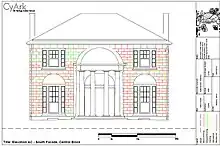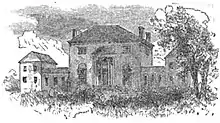Tudor Place
Tudor Place is a Federal-style mansion in Washington, D.C. that was originally the home of Thomas Peter and his wife,[3] Martha Parke Custis Peter, a granddaughter of Martha Washington. The property, comprising one city block on the crest of Georgetown Heights, had an excellent view of the Potomac River.
Tudor Place | |
.jpg.webp) South façade. | |
 | |
| Location | 1644 31st Street, NW Washington, D.C. |
|---|---|
| Coordinates | 38°54′38.91″N 77°3′48.02″W |
| Area | 5.5 acres |
| Built | 1815 |
| Architect | Dr. William Thornton |
| Architectural style | Federal |
| NRHP reference No. | 66000871 |
| Significant dates | |
| Added to NRHP | October 15, 1966[1] |
| Designated NHL | December 19, 1960[2] |
| Designated DCIHS | November 8, 1964 |
History
The original tract of land occupied by Tudor Place was part of the “Rock of Dumbarton” (originally, “Dunbarton”) tract in George Beall’s second addition to Georgetown, an area also known as Georgetown Heights. In 1794, Beall’s grandson, Thomas Beall, sold a portion of his land to Francis Lowndes, a merchant and importer from Bladensburg, Maryland. Lowndes owned the property for eleven years during which he constructed the two wings of the present historic house. Lowndes intended to complete the house but never did, instead selling the property to Martha and Thomas Peter. Martha and Thomas Peter contracted with Dr. William Thornton, who also designed the United States Capitol as well as The Octagon House, to design Tudor Place. From the two wings in existence, Thornton then provided the central structure and the joining elements to the wings - called hyphens, combined them with buff-colored stucco over brick. The "temple" porch and supporting columns provide a most striking addition to the front.
The garden and the collections are as rich and interesting as the home itself. A focal point is the collection of numerous objects that belonged to George and Martha Washington, making Tudor Place the largest public depository of objects belonging to the first Presidential family outside of Mount Vernon.The decorations included four chair-cushions embroidered by Martha Washington in 1801 "executed upon coarse canvas in a design of shells, done in brown and yellow wools, the highlights being flecked in gold-colored silk" as well as a decorative cover for a bed whose trimmings also were embroidered by Martha Washington.[4]
As a historic site that bears the scars of slavery, Tudor Place seeks to look this injustice in the eye. From Martha Washington's will, Martha Parke Custis Peter inherited 90 enslaved people. Enslaved workers and domestic servants worked and lived on site.
On September 28, 1811, Martha Peter's mother, Eleanor Calvert, age 56, a prominent member of the Calvert family of Maryland, Martha Washington's daughter-in-law, and George Washington's stepdaughter-in-law, died at Tudor Place.[5] Martha Peter noted in a February 15, 1812 letter to a friend, Eliza Susan Quincy (1798–1884), how important it was to Martha that she was able to spend the last fortnight of her mother's life with her mother at Tudor Place to render attentions that could not be paid elsewhere.[6]
In March 1813, after resigning his seat in the United States Congress, U.S. educator and political figure Josiah Quincy III and his wife, Eliza Susan Quincy, visited the Peters at Tudor Place.[7] While there, Mrs. Peter gave Josiah General Washington's silver gorget with the ribbon attached to it.[7] Washington's gorget, prominently featured in Charles Willson Peale's 1772 portrait of Colonel George Washington, was a metal collar designed to protect the throat of the wearer and Mrs. Peter had received the gorget at the division of her grandfather's estate.[7] Quincy gave the gorget to the Washington Benevolent Society of Boston in Mrs. Peter's name on April 13, 1813.[7][8][9]
On December 18, 1815, and on January 12, 1816, former United States Secretary of State Timothy Pickering visited the Peters at Tudor Place.[10]
Thomas and Martha Peter raised eight children in Tudor Place, and hosted the Marquis de Lafayette during his 1824 tour of the United States. When the third child and eldest son, John Parke Custis Peter, came of age, his father conveyed a farm around Seneca, Maryland. John P.C. Peter built a small replica of Tudor Place from 1828 to 1830 called Montevideo. The farm also included the redstone Seneca Quarry, whose stone Peter would bid on and win the Smithsonian Institution Building project in 1847.[11]
Following the death of Martha Peter in 1854, daughter Britannia Peter Kennon became the next owner of the home. She was the widow of Commodore Beverley Kennon I (1793–1844).[12] following their marriage ceremony in the house.[13]
In about 1869, Robert E. Lee, the former commanding general of the Confederate army in the 1861–1865 American Civil War, paid his last visit to the District of Columbia at Tudor Place before his death on October 12, 1870.[14] By 1874, Tudor Place was occupied by Thos. Beverley Kennon (1830–1890),[14] a grandson of Thomas Peter, a former U.S. Civil War captain with the Confederate Secret Service, and a post U.S. Civil War soldier under the Khedive of Egypt.[15] In 1890, the year that Beverley Kennon died and at a time when Brittania W. Kennon was the oldest living descendant of Mrs. Washington, The Century Illustrated Monthly Magazine published an extensive article that detailed the collection of Martha Washington's relics that were maintained inside Tudor Place.[4]
It was declared a National Historic Landmark in 1960.[2][16] Tudor Place is located at 1644 31st Street, N.W. and is open to the public.
 Library of Congress 1999 Historic American Buildings Survey No. DC 171 Architectural Drawing of the South Elevation of Tudor Place at 1:48 scale.
Library of Congress 1999 Historic American Buildings Survey No. DC 171 Architectural Drawing of the South Elevation of Tudor Place at 1:48 scale. Library of Congress 1999 Historic American Buildings Survey No. DC 171 Architectural Drawing of the Ground floor plan of Tudor Place at 1:48 scale.
Library of Congress 1999 Historic American Buildings Survey No. DC 171 Architectural Drawing of the Ground floor plan of Tudor Place at 1:48 scale. Library of Congress 1999 Historic American Buildings Survey No. DC 171 Architectural Drawing of the garden plan and tree schedule at 1:300 scale.
Library of Congress 1999 Historic American Buildings Survey No. DC 171 Architectural Drawing of the garden plan and tree schedule at 1:300 scale. This elevation of the Temple Portico of Tudor Place is from a laser scan project conducted by nonprofit CyArk. The circular Temple Portico that extends into the space of the Saloon is a prominent architectural feature of the house.
This elevation of the Temple Portico of Tudor Place is from a laser scan project conducted by nonprofit CyArk. The circular Temple Portico that extends into the space of the Saloon is a prominent architectural feature of the house. Image of Tudor Place from the South, point cloud data from a Laser scan project conducted by nonprofit CyArk.
Image of Tudor Place from the South, point cloud data from a Laser scan project conducted by nonprofit CyArk. Cutaway image of Tudor Place central interior, point cloud data from a Laser scan project conducted by nonprofit CyArk.
Cutaway image of Tudor Place central interior, point cloud data from a Laser scan project conducted by nonprofit CyArk. Pre-1874 engraving of Tudor Place.
Pre-1874 engraving of Tudor Place. A 1772 portrait of Colonel George Washington by Charles Willson Peale shows Washington's gorget, given to Josiah Quincy III in March 1813 by Martha Parke Custis Peter at Tudor Place.
A 1772 portrait of Colonel George Washington by Charles Willson Peale shows Washington's gorget, given to Josiah Quincy III in March 1813 by Martha Parke Custis Peter at Tudor Place. North façade.
North façade. Carriage House.
Carriage House.
See also
References
- "National Register Information System". National Register of Historic Places. National Park Service. January 23, 2007.
- "Tudor Place". National Historic Landmark summary listing. National Park Service. Retrieved September 4, 2009.
- Custis, George Washington Parke; Lee, Mary Randolph Custis (1859). Memoirs of Washington. Englewood Publishing Company. p. 37.
- "Some New Washington Relics". The Century Illustrated Monthly Magazine. The Century Company. 40: 16. 1890.
- "Died". The Lady's Miscellany, or, Weekly Visitor, for the Use and Amusement of Both Sexes. M'Carty & White. 13: 398. 1811.
Died. At Tudor Place, thereat of Thomas Peter, esq- near George-Town, Mrs. Eleanor Stuart, consort of David Stuart, esq.-of Osian Hall, in the county of Fairfax—in the 56th year of her age
- Quincy, Eliza Susan (1861). Memoir of the life of Eliza S.M. Quincy. J. Wilson and Son. p. 145.
- Lossing, Benson John (1859). Mount Vernon and its associations: historical, biographical, and pictorial. W.A. Townsend and Company. p. 345.
- Quincy, Eliza Susan (1861). Memoir of the life of Eliza S.M. Quincy. J. Wilson and Son. p. 165.
- Massachusetts Historical Society (1878). "Washington Benevolent Society of Massachusetts". Proceedings of the Massachusetts Historical Society. The Society. 15: 402.
At a quarterly meeting of the Washington Benevolent Society of Massachusetts, on Tuesday evening, April 13, 1813, the Hon. Mr. Quincy delivered to the President the Gorget of Washington, being a part of his uniform, when, as a colonel in the service of the State of Virginia, he served under General Braddock, in the war of 1756 ; having the arms of that State engraven thereon
- Pickering, Octavius; Upham, Charles Wentworth (1873). The life of Timothy Pickering. Vol. 4. Little, Brown and Company. p. 270.
- Peck, Garrett (2013). The Smithsonian Castle and the Seneca Quarry. The History Press. pp. 33–35.
- Jackson, Richard Plummer (1878). The chronicles of Georgetown, D.C., from 1751-1878. R. O. Polkinhorn. p. 32.
- "John R. Mott Weds Miss Agnes Peter" (PDF). New York Times. July 29, 1953. Retrieved March 15, 2017.
- Townsend, George Alfred (1874). Washington, outside and inside: A picture and a narrative of the origin, growth, excellencies, abuses, beauties, and personages of our governing city. J. Betts & Co. p. 621.
- "The Tudor Place Manuscript Collection". 2010. Archived from the original on June 14, 2011. Retrieved November 13, 2010.
MS-9. Captain Beverley Kennon II (1830-1890) Papers -- 0.3 linear foot. These papers span 1845-96, and contain fragmentary correspondence, legal and financial records, and printed material. They relate to Kennon's service during the Civil War with the Confederate Secret Service and later with the Khedive of Egypt. Captain Beverley Kennon II was the son of Commodore Beverley Kennon by his first marriage to Elizabeth Dandridge Claiborne.
- Morton, W. Brown, III (February 8, 1971). "National Register of Historic Places Inventory-Nomination Form: Tudor Place" (PDF). National Park Service. Archived from the original (pdf) on October 5, 2012. Retrieved November 19, 2015.
{{cite web}}: CS1 maint: multiple names: authors list (link) and Accompanying photos, exterior and interior, from 19___ accessdate=2015-11-19
External links
- Tudor Place Foundation
- Tudor Place: Democracy Starts at Home, from AIArchitect article from May 25, 2007
- Tudor Place Digital Media Archive (creative commons-licensed photos, laser scans, panoramas) from Tudor Place Foundation/CyArk partnership